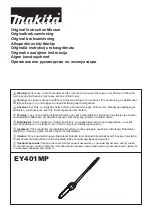
6
Securing workpiece
1
2
3
003986
By turning the vise handle counterclockwise and then
flipping the vise nut to the back, the vise is released from
the shaft threads and can be moved rapidly in and out. To
grip workpieces, push the vise handle until the vise plate
contacts the workpiece. Flip the vise nut to the front and
then turn the vise handle clockwise to securely retain the
workpiece.
CAUTION:
•
Always set the vise nut to the front fully when
securing the workpiece. Failure to do so may result
in insufficient securing of the workpiece. This could
cause the workpiece to be ejected or cause a
dangerous breakage of the wheel.
When the cut-off wheel has worn down considerably, use
a spacer block of sturdy, non-flammable material behind
the workpiece as shown in the figure. You can more
efficiently utilize the worn wheel by using the mid point on
the periphery of the wheel to cut the workpiece.
1
003987
When cutting workpieces over 85 mm wide at an angle,
attach a straight piece of wood (spacer) to the guide plate
as shown in the figure. Attach this spacer with screws
through the holes in the guide plate.
1
2
3
003988
If you use a spacer block which is slightly narrower than
the workpiece as shown in the figure, you can also utilize
the wheel economically when worn down the wheel.
1
2
3
4
5
003989
Long workpieces must be supported by blocks of
non-flammable material on either side so that it will be
level with the base top.
1
1
012058
OPERATION
Hold the handle firmly. Switch on the tool and wait until
the wheel attains full speed before lowering gently into the
cut. When the wheel contacts the workpiece, gradually
bear down on the handle to perform the cut. When the cut
is completed, switch off the tool and WAIT UNTIL THE
WHEEL HAS COME TO A COMPLETE STOP before
returning the handle to the fully elevated position.
CAUTION:
•
Proper handle pressure during cutting and
maximum cutting efficiency can be determined by
the amount of sparks that is produced while cutting.
Your pressure on the handle should be adjusted to
produce the maximum amount of sparks. Do not
force the cut by applying excessive pressure on the
handle. Reduced cutting efficiency, premature
wheel wear, as well as, possible damage to the tool,
cut-off wheel or workpiece may result.
Cutting capacity
Max. cutting capacity varies depending upon the cutting
angle and workpiece shape. Applicable wheel diameter:
355 mm
1. Blocks
1. Diameter of
workpiece
2. Guide plate
3. Spacer block
4. Width of spacer
block
5. Vise
1. Guide plate
2. Straight piece of
wood (Spacer)
3. Over 85mm long
1. Spacer block
1. Vise plate
2. Vise nut
3. Vise handle


























